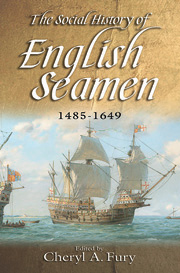Book contents
- Frontmatter
- Contents
- Illustrations
- Contributors
- List of Abbreviations
- Introduction
- 1 The English Maritime Community, 1500–1650
- 2 The Work of G.V. Scammell
- 3 The Men of the Mary Rose
- 4 Tudor Merchant Seafarers in the Early Guinea Trade
- 5 The Elizabethan Maritime Community
- 6 The Religious Shipboard Culture of Sixteenth and Seventeenth-Century English Sailors
- 7 Health and Health Care at Sea
- 8 The Relief of English Disabled Ex-Sailors, c. 1590–1680
- 9 Seamen's Wives and Widows
- 10 Jacobean Piracy: English Maritime Depredation in Transition, 1603–1625
- Conclusion
- Bibliography
- Index
9 - Seamen's Wives and Widows
Published online by Cambridge University Press: 05 September 2013
- Frontmatter
- Contents
- Illustrations
- Contributors
- List of Abbreviations
- Introduction
- 1 The English Maritime Community, 1500–1650
- 2 The Work of G.V. Scammell
- 3 The Men of the Mary Rose
- 4 Tudor Merchant Seafarers in the Early Guinea Trade
- 5 The Elizabethan Maritime Community
- 6 The Religious Shipboard Culture of Sixteenth and Seventeenth-Century English Sailors
- 7 Health and Health Care at Sea
- 8 The Relief of English Disabled Ex-Sailors, c. 1590–1680
- 9 Seamen's Wives and Widows
- 10 Jacobean Piracy: English Maritime Depredation in Transition, 1603–1625
- Conclusion
- Bibliography
- Index
Summary
Tudor-Stuart women seldom had an ‘easy go’ in life: this is particularly true of women who came from less affluent circumstances – that is to say, the vast majority. The Tudor era was rather unusual in that there was a consid-erable cluster of females who ruled England and Scotland during the mid to late sixteenth century. Although we have ample images and information on the exceptional women of the day, there is a paucity of records for their less illus-trious counterparts. While we are managing to reconfigure the lives of common seamen during the period, there are even greater challenges to analysing the lot of the women connected with the maritime world.
The existing records (such as wills, government documents and parish records) that are forthcoming about seamen, do not always reveal information about their wives and lovers. In some wills male testators referred only to ‘my wife’, leaving the women nameless to posterity. Although wills have proven to be a wealth of information about seamen, most of their wives and widows did not make last testaments: given the property laws at the time, wives rarely possessed anything to bequeath. Widows could be property-owners but most of those spouses who survived their seafaring husbands were left with little; widows could die intestate and their heirs would receive what little they had. As we shall see, seafaring widows frequently remarried, thereby relinquishing control of their property to their new spouses and once again, eliminating the need for their own last testament.
- Type
- Chapter
- Information
- The Social History of English Seamen, 1485-1649 , pp. 253 - 276Publisher: Boydell & BrewerPrint publication year: 2012

